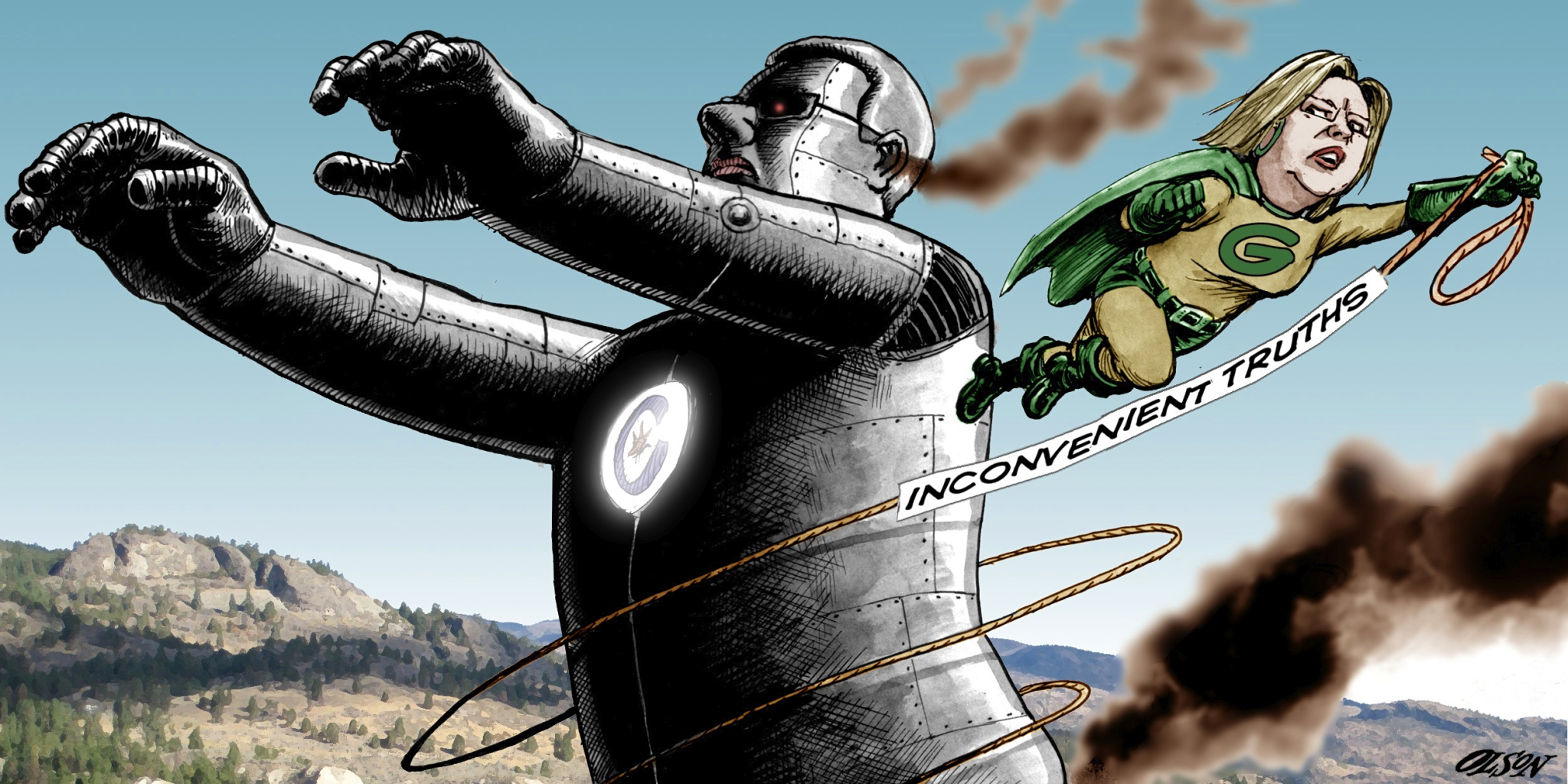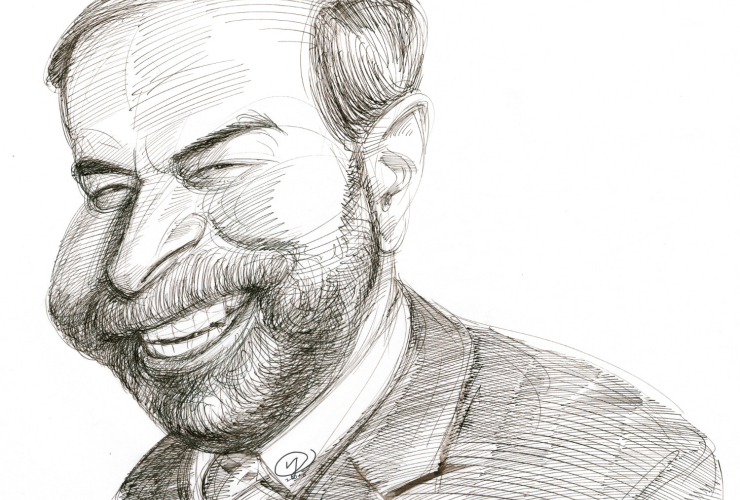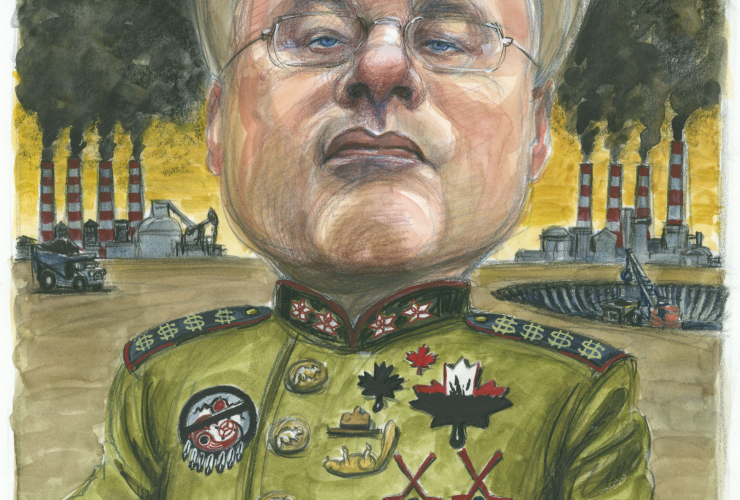Elizabeth May wants to save the planet – and just like in the best action movies, the clock is ticking.
The Green Party leader needs to accomplish three goals in Canada's 2015 federal election by October 19th . May must defeat her arch-villain, Stephen Harper; join forces with the NDP and the Liberals to form a coalition; and make her voice heard.
For an orator as accomplished as May, the last task doesn't seem difficult—but the old boys' club of federal politics is used to giving May the cold shoulder.
While the Green Party leader participated in the first of this year’s federal election debates, May has been excluded from two others upcoming. The Globe and Mail and Google Canada is hosting one, the Munk Debates organization the other.
It’s a familiar pattern. May was left out of the leadership debate in 2011. An attempt to exclude her in 2008 was reversed after a public outcry.
Nor are those the only snubs May’s received. In 2012, Conservative members twice withheld the unanimous consent May needed to take part in Remembrance Day speeches and speeches in tribute to Vaclav Havel, the late Czech Republic president, according to a profile of the politician in The Walrus.
The mainstream media treats her the same way, dishing out back-handed compliments. The Toronto Star recently referred to her as a “talented distraction,” while the National Post references her as “the mouse that roared.”
To much of the public, she is the leader of a party that snatches votes from the NDP and the Liberals, allowing the Conservatives to sneak up the middle for the win.
None of this deters the outspoken, feisty, 61-year-old. During the first days of August May stopped in to the National Observer’s offices for an editorial board meeting. Dressed in a sober blue suit, she fussed over journalists, making sure that they had coffee and water.
“I’m such a mom,” May laughed.
Being a "mom" might be May's alter-ego in the same way that Clark Kent is a reporter and Bruce Wayne a wealthy playboy, but don't let the sweetness fool you. May is incisive and blunt. She came to power as the former executive director of the Sierra Club who staked her ground on the environment. Since then her platform has broadened considerably to include democracy, the economy, healthcare and much more.
But leading into the 2015 election, while the Greens are running candidates across the country and trying to jump from two elected seats to 16, May has returned to her roots: defending the environment. The United Nations Climate Change Conference will be held in Paris hard on the heels of the Canadian election.
The newly-elected government will represent Canada at the Paris talks, and will either cement the country’s terrible reputation on the climate change file under Harper or rehabilitate it, depending on who’s elected to the prime minister’s office.
For Canada to lead on climate change, coalition politics is required to defeat the Tories. But May recognizes other parties are reluctant to play the junior partner and prop up another party because it leads to less support for them in the next election.
“I don’t care,” May said. “I’m not here to build up the Green Party and I know there are Green Party members that would be dismayed to hear me say it. I’m here because if we don’t get climate action soon, it will be far too late for any future election. This is it.”
May's mother a force of nature who wouldn't take no for an answer
Elizabeth May is a lot like her mother. Those who knew Stephanie May described her as a force of nature who wouldn’t take no for an answer. Married to an insurance company executive, Stephanie tirelessly worked as an activist from her home in Hartford, Connecticut, where May was born in 1954.
Stephanie campaigned against atmospheric weapon testing. Along with 17 Nobel laureates, including Linus Pauling and Bertrand Russell, she was a signatory to a lawsuit against the U.S., Britain and the Soviet Union over the testing. In 1960, she addressed some 100,000 people at a massive demonstration against nuclear weapons in London’s Trafalgar Square.
In the 1960s, Stephanie became part of the peace movement, taking out a second mortgage on the house and using the $30,000 toward the printing of a leaflet endorsing Eugene McCarthy as a presidential delegate. May recalls boxes of the political literature jamming the family home, leaving only narrow corridors in the living and dining rooms to squeeze through.
In the same way, Stephanie raised hundreds of thousands of dollars for candidates against the war in Vietnam. May remembers returning home from fund-raising parties at the homes of such celebrities as Arthur Miller and Paul Newman. Stephanie would drive while May counted the money, saying, “Here’s another $50,000.”
Through her work with the McGovern campaign, Stephanie met future president Bill Clinton. Such connections would come in handy. Later, Clinton would supply May with a reference, which would help her gain entrance to law school at Halifax’s Dalhousie University.
In 1973, the family left Hartford for their new home. The sandy beaches of Margaree Harbour set against the dramatic backdrop of Cape Breton’s mountains lured the Mays to Canada. They opened a gift shop and restaurant in the quiet but beautiful Nova Scotia community.
Even the relative solitude of Cape Breton didn’t diminish Stephanie’s activism. Later in life she used land she’d set aside for retirement in the region’s magnificent Bras D’Or Lakes to pay for court costs in a suit over the use of Agent Orange in the Maritimes.
May first came to the attention of the Canadian media campaigning against the chemical usage.
Her mother’s combination of environmental activism, selflessness and public service made a huge impression on May. She told this writer several years ago that her mother was “extraordinarily energetic, indomitable, intrepid. She was completely unlike anyone I’ve ever known.”
“She could see her way through to making huge changes against what might seem to be insurmountable odds.”
It almost sounds like May musing about herself. But as much as her mother helped shape May, May’s own activist and political experiences prepared her for political life and a leadership role.
May likes to know "where the bodies are buried"
In 1986, following law school and a two-year position as the associate general council for the Public Interest Advocacy Group, she joined then federal environment minister Tom McMillan’s office as senior policy advisor. During her time with McMillan, May helped create several national parks, including British Columbia's South Moresby, a spectacular coastal reserve of old growth cedar and Sitka spruce.
May also helped negotiate the Montreal Protocol, an international treaty designed to phase out various substances that broke down the ozone layer.
After McMillan granted permits for the Rafferty-Alameda Dams in Saskatchewan without environmental assessments, May resigned from the office. A federal court decision later turned down the permits on the grounds that they were illegally granted.
From the early 1980s on, May documented both her environmental battles and others in books, including Budworm Battles, Paradise Won: The Struggle to Save South Moresby, and Global Warming for Dummies (co-authored with Zoe Caron).
In 2006, after 17 years as the Sierra Club of Canada's executive director, May stepped down in 2006 to successfully run for the Green Party’s leadership.
May now lives in British Columbia and is fond of quoting Margaret Atwood, who she says “likes to know where all the bodies are buried.” May said that approach helped her in the recent federal leaders’ debate.
“There’s a very long list of areas of public policy that are left in tatters after nine years of Stephen Harper as prime minister and we’re going to have to rebuild Canada’s public policy, rebuild our civil service, rebuild our science, rebuild our veteran’s offices,” May said.
“There’s a long, long list. It’s important to remember that record, so I do remember the record. My approach to the debate was to make sure I was up to speed on data.”
It’s true that at times May seems to be Canada’s conscience, the individual who is holding the others in power responsible for their actions. To be sure, she’s only too happy to hold Harper’s feet to the fire for his terrible record on the environment and climate change.
Asked to assess the damage Harper has done to the environment sets off a tirade from the voluble May. According to her, within weeks of Harper’s rise to power in 2006, all the IPCC science on climate change was pulled off Environment Canada’s website.
At the same time that Canada backed out of the Kyoto Agreement, Harper canceled the existing climate change program unilaterally without a vote in the House, May said. “He began to cancel things that matter.”
Elizabeth May on the Paris climate summit in 2015
May begins to list a litany of things Harper has removed. In 2012, federal finance minister, Jim Flaherty, introduced Bill C-38 to act on measures introduced in that year’s budget. Roughly half the bill contained amendments weakening existing environmental laws.
From there the government failed to fund climate science, Parks Canada science, removed fisheries scientists and more, May said.
“There’s a litany of acts. I refer to them as serial vandalism because you find the same acts of public policy in our criminal justice system, immigration and refugee law, Statistics Canada, veteran’s affairs, health care, letting the health accord die, putting nothing in its place.
“Stephen Harper’s modus operandi appears to be destroying things.”
The Green Party needs to be in a position to wield influence
The Greens are prepared to introduce a massively ambitious platform on climate change, renewable technology and green transport, among other things.
On their website in point after point, they outline a program that would do everything from removing all subsidies and supports to the fossil fuel industry, to establishing a 100 per cent capital cost allowance for all businesses for energy retrofit costs.
The pages upon pages of promises are more than a platform; it’s a legacy – and legacies cost money. Many of the promises involve tax breaks, rebates, funding and other financial mechanisms.
To pay for the platform, May said the Greens would, among other things, raise the corporate tax rate, which currently stands at 15 per cent, to 19 per cent, bringing in some $6 billion annually. “It doesn’t make any sense to have a tax rate that’s the lowest in the industrialized world.”
Before she can do any of this, however, May needs to put the Greens in a position where they can wield some influence. The Greens are willing to work with the Liberals and the NDP – for a price. And the other parties, May suggests might be willing to pay that price in order to see their leader become prime minister.
“It’s all about the math and if you’re somebody who’s leading a federal political party, your goal is to be prime minister. That’s what you want and if you have to do a deal with Greens to make that happen you might just have to eat your words on a few things to get that deal with Greens,” May said.
For example, to work with the Liberals May would want them to repeal Bill C-51 and have the right polices going into the Paris climate change conference.
“There’s no question, particularly on C-51, the Liberal vote is despicable and unforgivable because this piece of legislation has no place in a democracy,” she said.
“Ideally, you know what I’d like best?” May rhetorically asked. “I’d like to force the Liberals and the NDP to agree on being together in a coalition and let the Greens sit in opposition. I think that would be best of both worlds.”
Do the Greens split the vote?
At last, with this question of a coalition between the parties, the issue of vote splitting comes up. Deserved or not, the Greens have the reputation of splitting the vote with the result that the Tories keep returning to rule.
May vigorously rejects the idea. “If it were true that Greens running were a plus for the Conservatives, Stephen Harper would be plugging me to be in every single debate and we know he’s doing the opposite.”
Instead, what May sees when she’s left out of debates is a shift in the dynamic between parties, with two ganging up on the third.
May insists that when she joins the debate, the focus switches to an attack on Harper, instead of on the Liberals or the NDP as has happened previously. She said that when she became Green Party leader her major concern wasn’t about winning seats. “My major concern was to be in the debate to make sure Harper couldn’t form government.”
Elizabeth May responds to criticism that the Greens split the vote enabling Harper's re-election
Her only motivation for running for the Green Party leadership, in fact for joining any political party at all, came from watching the way the 2005-06 election played out when the NDP downplayed climate change and instead focused on the Liberal sponsorship scandal to try and beat the party down.
“Now this was not about me being pro-Liberal, not a bit. I could see what would happen to the country if Stephen Harper was able to form the government… it led to this life-changing move for me to leave the NGO world, join a political party and run for leadership.”
Under Canada’s current first-past-the-post system, which favours two-party politics, May is unlikely to see a coalition. It comes as no surprise that she loathes the system, which she says should be listed in The Diagnostic and Statistical Manual of Mental Disorders “and noted as a mental health problem, hyper-partisanship, because it makes sensible, sane people do insane things, like allow Stephen Harper to become prime minister in 2006.”
Elizabeth May on eliminating Canada's first-past-the-post system
Yet if May wants to save the planet from global warming, she will have to persuade the NDP and the Liberals to work together. Given that Justin Trudeau has already rejected a coalition with the NDP, it could lead to yet another term for Harper and the Conservatives unless May is able to get the word out about the urgency for cooperation and that means participating in the debates. The clock is ticking.
Undaunted, May declares: “I’m very committed to saying that October 19th is Stephen Harper’s last day in office. I’m committed to it. I’m sure it will happen. I’m confident that having a voice in the federal election campaign, there are ways I can push it in that direction, and it’s way to early to be judging anything.”






Comments